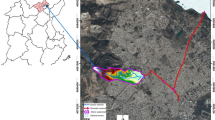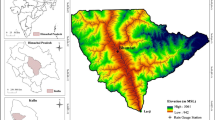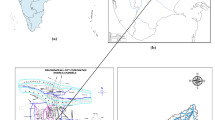Abstract
Investigating the hydrological response of an area to adverse climate changes and extreme rainfall events is crucial for managing land and water resources and mitigating the natural hazards like floods. Limited availability of the in situ data, especially in case of Transboundary Rivers, further highlights the need to develop and evaluate decision support systems which may predict the flows in real time using open source rainfall data. This paper presents the study conducted in Chenab River catchment, Pakistan, to develop and evaluate a hydrologic model using HEC-HMS for predicting flows based on TRMM rainfall data. The catchment was analyzed for hydro-morphological properties using SRTM DEM in HEC-GeoHMS. To rely on open source data as much as possible, digital soil map of the world developed by FAO and global land cover map developed by European Space Agency were utilized to compute Curve Number grid data for the catchment. These preliminary data analyses were employed to set initial values of different parameters to be used for model calibration. The model was calibrated for five rainfall events occurred in the rainy seasons of 2006, 2010 and 2013. The calibrated model was then validated for four other rainfall events of similar type in the same years. Consistency in simulated and observed flows was found with percent difference in volume ranging from −6.17 % to 5.47 % and percent difference in peak flows to be in the range of 6.96 % to 7.28 %. Values of Nash-Sutcliffe Efficiency were ranging from 0.299 to 0.909 with an average value of 0.586 for all flow events. The model was found well capable of capturing the hydrologic response of the catchment due to rainfall events and can be helpful in providing alerts of peak flows in real time based on real time/forecasted rainfall data.






Similar content being viewed by others
References
Abushandi E, Merkel B (2013) Modelling rainfall runoff relations using HEC-HMS and IHACRES for a single rain event in an arid region of Jordan. Water Resour Manag 27:2391–2409. doi:10.1007/s11269-013-0293-4
Adeyewa ZD, Nakamura K (2003) Validation of TRMM radar rainfall data over major climatic regions in Africa. J Appl Meteorol 42:331–347
Ahmad MM, Ghumman AR, Ahmad S (2009) Estimation of Clark’s Instantaneous Unit Hydrograph Parameters and Development of Direct Surface Runoff Hydrograph. Water Resour Manag 23(12):2417–2435 Retrieved from http://link.springer.com/article/10.1007/s11269-008-9388-8
Ali M, Khan SJ, Aslam I, Khan Z (2011) Landscape and urban planning simulation of the impacts of land-use change on surface runoff of Lai Nullah Basin in Islamabad, Pakistan. Landsc Urban Plan 102(4):271–279. doi:10.1016/j.landurbplan.2011.05.006
Azmat M, Laio F, Poggi D (2015) Estimation of Water Resources Availability and Mini-Hydro Productivity in High-Altitude Scarcely-Gauged Watershed. Water Resour Manag 29(14):5037–5054 Retrieved from http://link.springer.com/article/10.1007/s11269-015-1102-z
Che D, Mays LW (2015) Development of an Optimization/ Simulation Model for Real-Time Flood Control Operation of River-Reservoirs Systems. Water Resour Manag 29(11):3987–4005 Retrieved from http://link.springer.com/article/10.1007/s11269-015-1041-8
Cheema MJM, Bastiaanssen WGM (2012) Local calibration of remotely sensed rainfall from the TRMM satellite for different periods and spatial scales in the Indus Basin. Int J Remote Sens 33(8):2603–2627
Chen Y, Xu Y, Yin Y (2009) Impact of land use change scenarios on storm-runoff generation in Xitiaoxi basin, China. Quat Int 1:1–8
Dariane AB, Javadianzadeh MM, James LD (2016) Developing an efficient auto-calibration algorithm for HEC-HMS program. Water Resour Manag 30:1923–1937. doi:10.1007/s11269-016-1260-7
De Silva MMGT, Weerakoon SB, Herath S (2014) Modeling of Event and Continuous Flow Hydrographs with HEC – HMS : Case Study in the Kelani River Basin, Sri Lanka. J. Hydrol. Eng. ASCE 19(4):800–806. doi:10.1061/(ASCE)HE.1943-5584.0000846.
Dinku T, Ceccato P, Grover-Kopec E, Lemma M, Connor SJ, Popelewski CF (2007) Validation of satellite rainfall products over East Africa’s complex topography. Int J Remote Sens 28:1503–1526
ESA (2010) GlobeCover2009 version 2.3. Retrieved from http://due.esrin.esa.int/globcover/
FAO (2007) Digital Soil Map of World, Version 3.6. Retrieved from http://www.fao.org/geonetwork/srv/en/metadata.show?id=14116
Halwatura D, Najim MMM (2013) Environmental Modelling & Software application of the HEC-HMS model for runoff simulation in a tropical catchment. Environ Model Softw 46:155–162. doi:10.1016/j.envsoft.2013.03.006
http://www2.jpl.nasa.gov/srtm/ (n.d.) Retrieved from http://www2.jpl.nasa.gov/srtm/
Immerzeel WW, Droogers P, de Jong SM, Bierkens MFP (2009) Large-scale monitoring of snow cover and runoff simulation in Himalayan river basins using remote sensing. Remote Sens Environ 113(1):40–49
IPCC (2012) Managing the risks of extreme events and disasters to advance climate change adaptation. A Special Report of Working Groups I and II of IPCC. Cambridge
IPCC (2014) IPCC Fifth Assessment Synthesis Report
Laouacheria F, Mansouri R (2015) Comparison of WBNM and HEC-HMS for runoff hydrograph prediction in a small urban catchment. Water Resour Manag. doi:10.1007/s11269-015-0953-7
Loukas A, Quick MC (1996) Physically-based estimation of lag time for forested mountaneous watersheds. Hydrol. Sci 41(1):1–19
Merwade V. (2012) Creating SCS Curve Number Grid using HEC-GeoHMS. Retrieved from http://web.ics.purdue.edu/~vmerwade/tutorial.html
Nash JE, Sutcliffe JV (1970) River flow forecasting through conceptual models: Part I - A Discussion of Principles. J Hydrol 10:282–290
Papathanasiou C, Serbis D, Mamassis N (2013) Flood mitigation at the downstream areas of a transboundary river. Water Utility Journal 3:33–42
Qamar MU, Ganora D, Claps P (2015) Monthly runoff regime regionalization through dissimilarity-based methods. Water Resour Manag 29. doi:10.1007/s11269-015-1087-7
Qureshi AS (2011) Water Management in the Indus Basin in Pakistan : challenges and opportunities. Mt Res Dev 31(3):252–260
Rees GH, Collins DN (2005) Regional differences in response of flow in glacier-fed-Himalayan rivers to climate warming. Hydrol Process 20(10):2157–2169
Russel SO, Kenning BFI, Sunnell GJ (1979) Estimating design flows for urban drainage. J. Hydraul. Div. 105(1):43–52
Shahid MA, Boccardo P, Garcia WC, Albanese A, Cristofori E (2013) Evaluation of TRMM Satellite Data for Mapping Monthly Precipitation in Pakistan by Comparison with Locally Available Data. In: III CUCS Congress - Imagining Cultures of Cooperation. Universities working to face the new developemnt challenges, Turin
Shrestha S, Khatiwada M, Babel MS, Parajuli K (2014) Impact of Climate Change on River Flow and Hydropower Production in Kulekhani Hydropower Project of Nepal. Environ. Process. 1:231–250. doi:10.1007/s40710-014-0020-z
Singh P, Ramasastri KS, Kumar N (1995) Topographical influence on precipitation distribution in different ranges of western Himalays. Nord Hydrol 26:259–284
Singh P, Jain SK, Kumar N (1997) Estimation of snow and glacier-melt contribution to the Chenab River, Western Himalaya. Mt Res Dev 17(1):49–56
USACE (1994) Flood-Runoff Analysis, Engineer Manual 1110–2–1417. Washington, D. C
USACE (2000) Hydrologic Modeling System (HEC-HMS) Technical Reference Manual. Washington, D. C
USACE (2008) Hydrologic Modeling System (HEC-HMS) Applications Guide
USDA-NRCS (1986) TR-55: Urban Hydrology for Small Watersheds
USDA-NRCS (2007) Chapter 7: Hydrologic Soil Groups. In National Engineering Handbook of Hydrology (Part 630)
USDA-NRCS (2010) National Engineering Handbook Chapter 15, Time of Concentration
Villarini G, Krajewski WF (2007) Evaluation of the research version TMPA three-hourly 0.25 × 0.25 rainfall estimates over Oklahoma. Geophys Res Lett 34
Yannopoulos S, Eleftheriadou E, Mpouri S, Giannopoulou I (2015) Implementing the Requirements of the European Flood Directive: the Case of Ungauged and Poorly Gauged Watersheds. Environ. Process. 2:S191–S207. doi:10.1007/s40710-015-0094-2
Acknowledgments
This study was technically supported by ITHACA Research Center regarding TRMM satellite data processing and use. The authors acknowledge all the free data sources viz. NASA for SRTM DEM and TRMM data, FAO for digital soil map, ESA for global land cover map, and US Army Corps of Engineers (USACE) for open-source HEC-HMS model. Special thanks to Higher Education Commission (HEC) of Pakistan for providing financial support in the form of PhD scholarship to conduct research activities.
Author information
Authors and Affiliations
Corresponding author
Rights and permissions
About this article
Cite this article
Shahid, M.A., Boccardo, P., Usman, M. et al. Predicting Peak Flows in Real Time through Event Based Hydrologic Modeling for a Trans-Boundary River Catchment. Water Resour Manage 31, 793–810 (2017). https://doi.org/10.1007/s11269-016-1435-2
Received:
Accepted:
Published:
Issue Date:
DOI: https://doi.org/10.1007/s11269-016-1435-2




